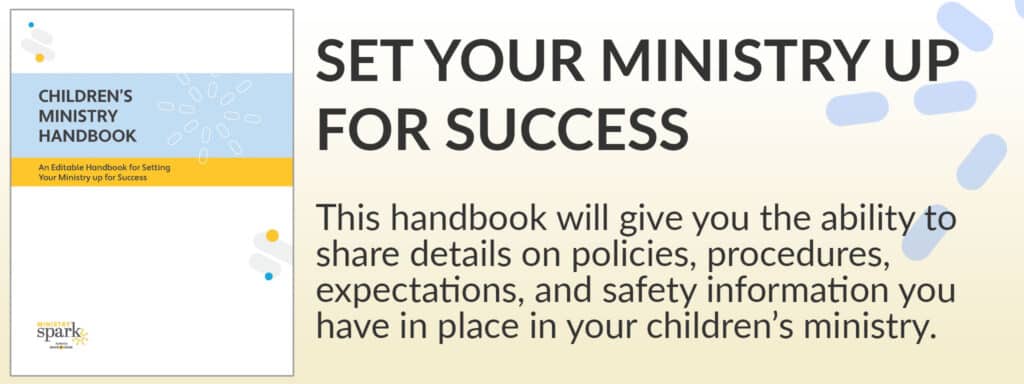Your kids’ ministry space should be the safest place on your church’s campus. And the right security practices can help you do that.
Security and safety may not be fun, but having set policies and procedures is fundamental to a growing kids’ ministry. Why? As we know, kids’ ministry is usually the first place a family experiences your church and a child connects with God and His people.
And on top of that, I cannot overstate the importance of having a plan for kids’ ministry security practices. By prioritizing safety, we protect our kids and safeguard the integrity and reputation of our ministry.
You see, classroom safety and security is not just about preventing harm; it’s about creating an environment where children feel safe, supported, and free to learn and grow.
“Let everything be done in a fitting and proper manner that is organized and well-planned.”
1 Corinthians 14:40


Security Practices: Ways to Protect Children
Volunteer Ratios
Establish clear guidelines for how many adult volunteers should be in each classroom. The minimum should be two. From there, look at your state ratios and then go under them so you have more adult volunteers than technically required.
Why do I personally go under state ratios?
- We believe in small groups. Teaching God’s Word is important, and we believe it is done best in small groups.
- We are not all professionals, and we do not require our volunteers to be professionals or early educators. We cannot do what early educators do, so we cannot use the same ratios they do.
- Teens are not adults. We love having teenagers serving on our teams, but we must remember that teens are not adults and do not count toward the adult total in the ratio.
It’s about creating an environment where children feel safe, supported, and free to learn and grow.
Bathroom Policies
Develop strict bathroom policies, such as requiring two unrelated adults to accompany young children to the restroom.
You may need a diaper-changing policy. Some churches do not change diapers, and some do. Before you decide whether or not you need a policy in place, discuss it with your staff, insurance company, and some faithful parents.

Close the Doors
I get it. Having to close a room feels like the worst thing. Some senior leadership may say this is not even allowed. However, if your ratios are out of whack and the number of children in the space violates the fire code, then make it stop.
Close the room.
It would be best if you made it clear to your senior leadership that you will close rooms, so you don’t endanger the children you serve.
One Way
Of course, you want to have many exits, but as a security practice for entry and parent pick-up, you should only have one. Make all parents funnel through one entrance.
I was known for having “bouncers” at our primary drop-off and pick-up point. We limited parent pick up to one person. The only way you got through the bouncers was if you had the pick-up ticket. If you did not, you had to return to the front desk for a reprint.
Parents said this system made them feel very safe, and teachers noted that they did not feel overwhelmed by multiple family members coming to pick up.
Never Alone
No adult should ever be alone with a child. This includes an adult being alone with a teen team member. Some churches call this the “Rule of 3.”
- 2 adults and 1 child
- 1 adult and 2 children
Here’s an example on how to follow the Rule of 3: if one adult and one teen reported to a room to volunteer, I would ask the adult to stand in the doorway, visible from the hall, until more children or adults arrived.
Emergency Procedures
Regularly communicate about emergency procedures, including fire, lockdown, and evacuation drills, so volunteers know how to respond calmly and quickly in a crisis.
Have a paper roster and a sign-in sheet printed for each class. This paper seems so old school, but in an emergency when the computers do not work, or you need a prompt response, the lead teacher will always know who is in their class.
Surveillance Cameras
A key security practice is to install cameras to strategically monitor activity and deter potential threats.
Make sure you have a list of those approved to review the footage and that it is never reviewed alone. Two people always. Keep a log where you can note the date and time you are viewing, who is viewing, why you are viewing, and what the outcome was.
Safety builds trust. Trust is the foundation of a good children’s ministry program.
Write It Down
Ensure you have a blank incident report in every room and that every room leader knows how and when to use them.
We always immediately get the parent for:
- Anything neck up
- Anything bleeding or open skin
- Anything swollen
- Anything broken or bruised
- If the child asks for their parent
My rule for when to fill out an incident form—
- If the child is hurt. Ouch is enough!

Ways to Protect Your Ministry
‘Make Them Wait’ Security Practice
The best practice is to have a standard waiting period to serve. Some churches have one month, and some have six months. Whatever the waiting period is, enforce it consistently.
If someone wants to join your team for the wrong reasons, they will likely not remain if you make it difficult.
Call References
Call at least two non-related references.
Background Checks
Conduct thorough background checks on all volunteers and staff to ensure they are suited to working with children.
Documentation
Keep detailed records of incidents, training sessions, and security measures to legally protect you and the ministry.
Insurance
Ensure that your ministry has comprehensive liability insurance to protect against potential claims. Be diligent to follow their requirements and any of their suggested best practices.
Paper seems so old school, but in an emergency, when the computers do not work, or you need a prompt response, the lead teacher will always know who is in their class.
Practical Implementation Ideas
Implementing these security measures can seem daunting but breaking it down into manageable steps can make the process smoother.
Security Practices: Start with an Assessment
Conduct a security assessment to identify potential vulnerabilities and prioritize actions. Do not rely on your eyes alone. Ask volunteers, security team members, and even local police to walk through and give you a list of weak areas.
Develop a Plan
Create a detailed security plan outlining procedures, responsibilities, and needed resources. Each item on your plan should include a point of contact, the deadline to implement a new procedure, and a date to review.
Communicate and Train
Clearly communicate the plan to all staff and volunteers, put it in writing (in a handbook), and provide regular training sessions.
Evaluate and Adjust
Regularly review and update the security plan based on feedback and changing best practices.
Encouragement for Leaders
Safety is felt upon arrival, seen in the building, heard in the hallways, and read throughout policies. It is a hard thing to do, but it’s the thing you must do first. Safety comes before growth, safety comes before the curriculum, and safety comes before everything else! And when your space is safe, it makes growth, teaching, and volunteer recruitment easier.
Safety builds trust. Trust is the foundation of a good children’s ministry program. Build trust through safe practices, and your ministry will stand secure on that foundation for years.










